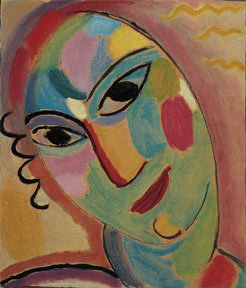Alexei Jawlensky
dal 3/5/2007 al 4/11/2007
Segnalato da
3/5/2007
Alexei Jawlensky
Norton Simon Museum, Pasadena
Solo show (1864-1941). An exhibition featuring more than 100 paintings and works on paper. Motivated by an inner response to his subject matter, and influenced by sources such as medieval art, folk art and non-Western art, the artist created subjective, highly emotional and spiritual images composed of distorted forms and non-naturalistic colors.

Solo show (1864–1941)
The Norton Simon Museum presents Alexei Jawlensky (1864–1941), an exhibition featuring more than 100 paintings and works on paper by this renowned 20th-century artist. One of the Blue Four, a group of Expressionist artists represented by dealer Emmy (Galka) Scheyer, Jawlensky and his contemporaries redefined modern art with an innovative artistic philosophy that rejected the idea of an objective reality. Motivated by an inner response to their subject matter, and influenced by sources such as medieval art, folk art and non-Western art, these artists created subjective, highly emotional and spiritual images composed of distorted forms and non-naturalistic colors.
The installation at the Norton Simon Museum includes works from the major phases of Jawlensky’s career, including such series as “Variations on a Landscape Theme,” “Mystical Heads,” and “Meditations.” In addition, the special friendship between Jawlensky and Scheyer is brought to light through a fascinating collection of archival materials and photographs.
About Jawlensky and The Blue Four Galka Scheyer Collection at the Norton Simon Museum
Alexei Jawlensky, born in Russia in 1864, began to study with Realist painter Ilya Repin while he was a lieutenant in the Russian Imperial Army. After resigning his military commission in 1896, Jawlensky left Russia to study art in Munich, where his personal style started to take shape under the influence of the French Fauves and the German Expressionists. Around 1910 he settled on his primary theme, the human head, with a series of boldly colored, stylized portraits.
At the outbreak of World War I in 1914, Jawlensky fled to Switzerland. There, he began to create his “Variations on a Landscape Theme,” a series of abstract landscapes inspired by the view from his window. From 1917 until the end of his career, he continued his explorations of the serial image by returning to the theme of the human head, culminating in his “Meditations” series of the 1930s.
The story of Galka Scheyer and Jawlensky begins in 1916, when Scheyer visited the Exhibition of Russian Artists in Lausanne, Switzerland and saw Jawlensky’s paintings for the first time. Immediately captivated by the artist’s images, Scheyer traveled to meet him, and a lifelong friendship ensued. Scheyer became Jawlensky’s dealer and agent, and worked tirelessly to promote his art through various exhibitions and lectures in Germany. In 1924, Scheyer left Germany for the United States, and there devoted the rest of her life to creating a public for the group of artists she named the Blue Four: Jawlensky, Paul Klee, Vasily Kandinsky and Lyonel Feininger.
In 1953, the Pasadena Art Institute, the precursor to the Pasadena Art Museum (and eventually the Norton Simon Museum), received a bequest by Scheyer’s estate of 450 artworks and 800 documents, including over 150 paintings and works on paper by Alexei Jawlensky. Her gift comprises The Blue Four Galka Scheyer Collection at the Norton Simon Museum.
About Galka Scheyer
Galka Scheyer was born Emilie Ester Scheyer in 1889 in Braunschweig, Germany. An art collector, dealer, and supporter of the avant-garde, she is best known as the founder of the Blue Four artists’ group. A champion of modern art, Scheyer was responsible for the first presentations in America of some of the major figures of European modernism.
Scheyer came to the United States in 1924 to promote the work of the Blue Four. Originally residing in New York, she moved to San Francisco in 1925. In 1926, Scheyer arranged the first Blue Four exhibitions in California—in Oakland and Los Angeles. They were followed in 1927 and 1928 by European Modernists exhibitions, which included the Blue Four artists as well as Archipenko, Nolde, Kirchner, Picasso, Matisse, and others. Scheyer moved to Los Angeles in 1930 and into an apartment in architect Rudolph Schindler’s Kings Road house, where she had space to hang her collection. As of 1933, Galka Scheyer had settled permanently in Los Angeles, where she spent her time writing, lecturing, arranging sales and organizing exhibitions of the Blue Four and other modernists.
Norton Simon Museum
411 West Colorado Blvd. at Orange Grove Blvd. - Pasadena
Hours: open every day except Tuesday, from 12:00 p.m. to 6:00 p.m., and 12:00 p.m. to 9:00 p.m. on Friday.
Admission: General admission is dollars 8.00 for adults and dollars 4.00 for seniors.



